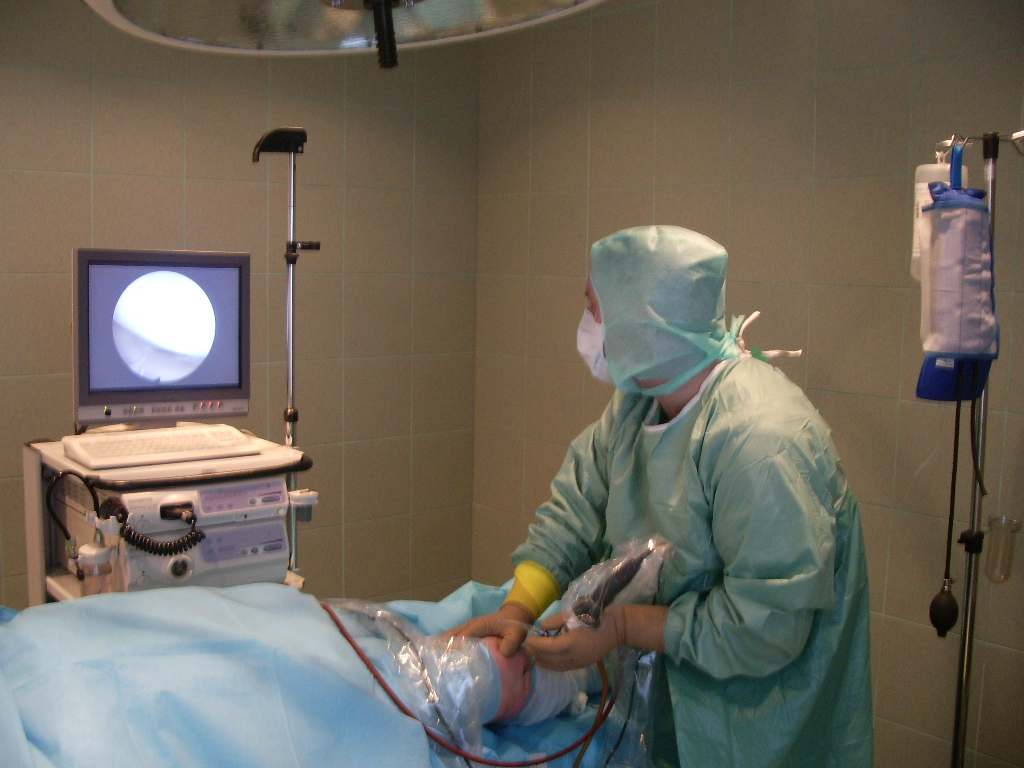In our clinic we do orthopaedics operations:
- shoulder-, knee-, wrist-, elbow- and ankle joint arthroscopies
- carpal tunnel syndrome
- Hallux operations
- Also many other operations
What is Arthroscopy?
Arthroscopy, modern method of joint surgery, turned out to be very efficient pain eliminating operation method in joint surgery. At the present time arthroscopy is the most performed operation in the world, operation goes without typical operative wounds. 2-3 small 5mm incisions are made, through which an optical system is delivered into joint bringing an enlarged color picture from joint inside to display, where every mm of joint can be seen. Surgeon action goes along with the display picture and if it is necessary required instruments are delivered through other small incisions for injury elimination, healing. Absence of big operative wounds significantly hastens post operative recovery and recuperation.
What is carpal tunnel syndrome?
Carpal tunnel syndrome (CTS) is a condition brought on by increased pressure on the median nerve at the wrist. In effect, it is a pinched nerve at the wrist. Symptoms may include numbness, tingling, and pain in the arm, hand, and fingers. There is a space in the wrist called the carpal tunnel where the median nerve and nine tendons pass from the forearm into the hand (see Figure 1). Carpal tunnel syndrome happens when pressure builds up from swelling in this tunnel and puts pressure on the nerve. When the pressure from the swelling becomes great enough to disturb the way the nerve works, numbness, tingling, and pain may be felt in the hand and fingers (see Figure 2).
What causes carpal tunnel syndrome?
Usually the cause is unknown. Pressure on the nerve can happen several ways: swelling of the lining of the flexor tendons, called tenosynovitis; joint dislocations, fractures, and arthritis can narrow the tunnel; and keeping the wrist bent for long periods of time. Fluid retention during pregnancy can cause swelling in the tunnel and symptoms of carpal tunnel syndrome, which often go away after delivery. Thyroid conditions, rheumatoid arthritis, and diabetes also can be associated with carpal tunnel syndrome. There may be a combination of causes.
Signs and symptoms of carpal tunnel syndrome
Carpal tunnel syndrome symptoms usually include pain, numbness, tingling, or a combination of the three. The numbness or tingling most often takes place in the thumb, index, middle, and ring fingers. The symptoms usually are felt during the night but also may be noticed during daily activities such as driving or reading a newspaper. Patients may sometimes notice a weaker grip, occasional clumsiness, and a tendency to drop things. In severe cases, sensation may be permanently lost and the muscles at the base of the thumb slowly shrink (thenar atrophy), causing difficulty with pinch.
Diagnosis of carpal tunnel syndrome
A detailed history including medical conditions, how the hands have been used, and whether there were any prior injuries is important. An x-ray may be taken to check for the other causes of the complaints such as arthritis or a fracture. In some cases, laboratory tests may be done if there is a suspected medical condition that is associated with CTS. Electrodiagnostic studies (NCV–nerve conduction velocities and EMG–electromyogram) may be done to confirm the diagnosis of carpal tunnel syndrome as well as to check for other possible nerve problems.
Treatment of carpal tunnel syndrome
Symptoms may often be relieved without surgery. Identifying and treating medical conditions, changing the patterns of hand use, or keeping the wrist splinted in a straight position may help reduce pressure on the nerve. Wearing wrist splints at night may relieve the symptoms that interfere with sleep. A steroid injection into the carpal tunnel may help relieve the symptoms by reducing swelling around the nerve. When symptoms are severe or do not improve, surgery may be needed to make more room for the nerve. Pressure on the nerve is decreased by cutting the ligament that forms the roof (top) of the tunnel on the palm side of the hand (see Figure 3). Incisions for this surgery may vary, but the goal is the same: to enlarge the tunnel and decrease pressure on the nerve. Following surgery, soreness around the incision may last for several weeks or months. The numbness and tingling may disappear quickly or slowly. It may take several months for strength in the hand and wrist to return to normal. Carpal tunnel symptoms may not completely go away after surgery, especially in severe cases.
Hallux Rigidus
Hallux rigidus usually develops in adults between the ages of 30 and 60 years. No one knows why it appears in some people and not others. It may result from an injury to the toe that damages the articular cartilage or from differences in foot anatomy that increase stress on the joint.
Symptoms
Pain in the joint when you are active, especially as you push-off on the toes when you walk Swelling around the joint A bump, like a bunion or callus, that develops on the top of the foot Stiffness in the great toe and an inability to bend it up or down
Surgical Treatment
Arthrodesis (are-throw-dee’-sis) Fusing the bones together (arthrodesis) is often recommended when the damage to the cartilage is severe. The damaged cartilage is removed and pins, screws, or a plate are used to fix the joint in a permanent position. Gradually, the bones grow together. This type of surgery means that you will not be able to bend the toe at all. However, it is the most reliable way to reduce pain in these severe cases. For the first six weeks after surgery, you will have to wear a cast and then use crutches for about another six weeks. You won’t be able to wear high heels, and you may need to wear a shoe with a rocker-type sole.


